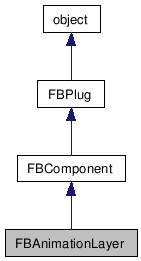

This class permits you to access animation layer properties and modify them. Changing the various properties of the layers will modify how the animation will be interpreted. For example, muting a layer will mute all the animation contained on the layer. You can access the animation layer object from the take, usign the FBTake::GetLayer() and FBTake::GetLayerByName(). See the FBTake class for more details.
See sample: AnimationLayers.py.
Public Member Functions |
|
| FBAnimationLayer (str pName, int pLayerID) | |
| Constructor. |
|
| AddChildLayer (FBAnimationLayer pAnimationLayer) | |
| Add a child to the layer. |
|
| FBDelete () | |
| Virtual FBDelete function. |
|
| int | GetChildCount () |
| Get the child layer count of this layer.
|
|
| FBAnimationLayer | GetChildLayer (int pIndex) |
| Get the nth child layer of this layer.
|
|
| GetCompleteChildHierarchy (FBArrayTemplate< FBAnimationLayer > pChildArray) | |
| Get the all the children hierarchy of the
layer, including children not directly connected to this layer.
|
|
| int | GetLayerIndex () |
| Get the layer index. |
|
| FBAnimationLayer | GetParentLayer () |
| Get the parent layer. |
|
| bool | IsSelected () |
| Verify if the layer is selected. |
|
| SelectLayer (bool pValue, bool pExclusiveSelect) | |
| Select the layer. |
|
| SetParentLayer (FBAnimationLayer pParentLayer) | |
| Set the parent layer. |
|
Public Attributes |
|
| FBLayerMode | LayerMode |
| Read Write Property: Layer mode. By
default, the layer is in kFBLayerModeAdditive mode. Cannot be
applied to the BaseAnimation Layer. |
|
| FBLayerRotationMode | LayerRotationMode |
| Read Only Property: Layer rotation
mode. Cannot be applied to the BaseAnimation Layer. |
|
| bool | Lock |
| Read Write Property: If true, the
layer is locked. You cannot modify keyframes on a locked layer.
|
|
| bool | Mute |
| Read Write Property: If true, the
layer is muted. A muted layer is not included in the result
animation. Cannot be applied to the BaseAnimation Layer. |
|
| bool | Solo |
| Read Write Property: If true, the
layer is soloed. When you solo a layer, you mute other layers that
are at the same level in the hierarchy, as well as the children of
those layers. Cannot be applied to the BaseAnimation Layer.
|
|
| FBAnimatableDouble | Weight |
| Read Write Property: The weight value
of a layer determines how much it is present in the result
animation. Takes a value from 0 (the layer is not present) to 100.
The weighting of a parent layer is factored into the weighting of
its child layers, if any. BaseAnimation Layer always has a Weight
of 100. |
|
| FBAnimationLayer | ( | str | pName, | |
| int | pLayerID | |||
| ) |
Constructor.
| pName | Name of the animation layer. | |
| pLayerID | ID to set for the new layer. |
| AddChildLayer | ( | FBAnimationLayer | pAnimationLayer | ) |
Add a child to the layer.
Layer ID of the new child layer might change after parenting depending where the child layer was originally located.
| pAnimationLayer | Layer to set as a child. |
| FBDelete | ( | ) |
| int GetChildCount | ( | ) |
Get the child layer count of this layer.
The count will only includes direct child of the layer.
| FBAnimationLayer GetChildLayer | ( | int | pIndex | ) |
Get the nth child layer of this layer.
| pIndex | Index of the child layer to get. |
| GetCompleteChildHierarchy | ( | FBArrayTemplate< FBAnimationLayer > | pChildArray | ) |
Get the all the children hierarchy of the layer, including children not directly connected to this layer.
| pChildArray | Array of child layers, will be filled by the function. |
| int GetLayerIndex | ( | ) |
Get the layer index.
| FBAnimationLayer GetParentLayer | ( | ) |
Get the parent layer.
| bool IsSelected | ( | ) |
Verify if the layer is selected.
Select the layer.
This is the equivalent of selecting the layer in the UI in the Animation Layer Editor tool
| pValue | True if the layer will be selected, false otherwise. | |
| pExclusiveSelect | If pValue is true, passing true will deselect all the other layers, creating an exclusive selection. |
| SetParentLayer | ( | FBAnimationLayer | pParentLayer | ) |
Set the parent layer.
| pParentLayer | pointer to the parent layer or NULL if you want to unparent the layer. |
Read Write Property: Layer mode. By default, the layer is in kFBLayerModeAdditive mode. Cannot be applied to the BaseAnimation Layer.
Read Only Property: Layer rotation mode. Cannot be applied to the BaseAnimation Layer.
Read Write Property: If true, the layer is locked. You cannot modify keyframes on a locked layer.
Read Write Property: If true, the layer is muted. A muted layer is not included in the result animation. Cannot be applied to the BaseAnimation Layer.
Read Write Property: If true, the layer is soloed. When you solo a layer, you mute other layers that are at the same level in the hierarchy, as well as the children of those layers. Cannot be applied to the BaseAnimation Layer.
| FBAnimatableDouble Weight |
Read Write Property: The weight value of a layer determines how much it is present in the result animation. Takes a value from 0 (the layer is not present) to 100. The weighting of a parent layer is factored into the weighting of its child layers, if any. BaseAnimation Layer always has a Weight of 100.
 1.5.3
1.5.3